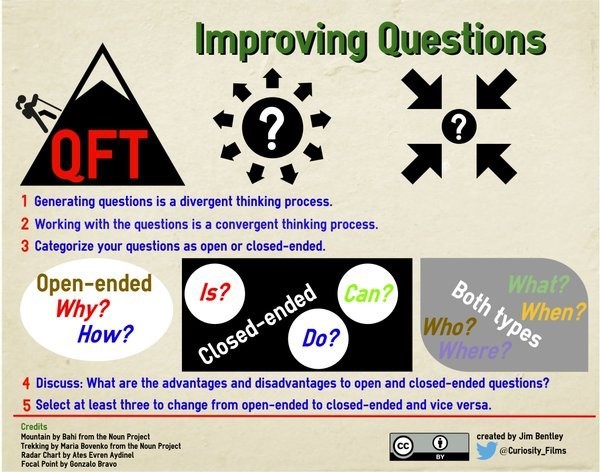
Mathematics is a revolving door of questions. In the readings for the first four chapters of Make just one change: Teach students to ask their own questions it is discussing the importance of students forming their own questions. Examining each chapter has led to a deeper understanding of how important it is for students to formulate questions. How do we get students to formulate questions?
Forward and Introduction
In this chapter we are introduced to Questioning Formulation Technique (QFT). QFT is a well-ordered strategy intended to encourage the asking of numerous questions. It is a helpful instrument for model teaching (Rothstein & Santana, 2017). There are 6 parts to this method that assist in providing confidence, active learning, new concepts and improved solutions. These six parts are:
- Teacher question focus
- Student question focus
- Creating closed and open-ended questions
- Prioritization questions
- How to use questions
- Reflection of learning (Rothstein & Santana, 2017)
Chapter 1 QFT
QFT, as listed above is a strategy to assist in generating questions. It is focused on three types of thinking:
- Divergent-creative thinking
- Convergent-analyzation of questions
- Metacognition- think about own thinking (Rothstein & Santana, 2017).
This process leads is a way to formulate a student’s own questioning. That therefore leads to self-learning.
Chapter 2 Question Focus
This is the section that discusses steps to keep students on track. Students will receive steps on how to have The Question Focus (QFocus). Rothstein and Santana list steps that can assist provoke new thinking and not be bias. These steps are:
- “Identify the purpose
- Generate QFocus ideas
- Identify pros and cons of each
- Choosing the QFocus and assessing it
- Imagine possible questions expected (2017).”
Chapter 3 Introduce the Rules for Producing Questions
There are rules that we must introduce to students every time we begin new methods with our students. The rules are there to make the QFT process be a safe and even playing field. This is a model that is used to assist understanding while pursing the goal of keeping the students focused, no discussion, no judging and no ways to try to answer the questions (Rothstein & Santana, 2017).
Chapter 4 Students Produce the Questions
This chapter in explaining the students producing of questions. When students develop their own questions, they will expand their thinking and learning. Teachers have steps that they must take to assist the students in with their formulation of the questions. The teachers must first give examples of the questions. Next, they will divide the students into groups and introduce the QFocus. At this point they will have a few minutes to produce their questions with teacher monitoring (Rothstein &Santana, 2017).
A teacher practice of QFT
Personally, I have yet to use this strategy in my teaching. I can see the benefits of utilizing this method and hope to introduce it into my instruction. I was looking for tips of how other teachers or teacher’s aids have utilized this strategy. I found a post, by Jay Corrigan, where he describes the steps, he took with introducing this to his students. He expressed how the questions his students came up with showed him it was not difficult and that it was a great assessment. Corrigan stated, “I have seen the power of the Question Formulation Technique first hand, its power not only to motivate students to take ownership of their own learning but also as a formative assessment teacher can use to match instruction to readiness level (2013). This gives insight as to how effective QFT really is.
Resources
- Corrigan, J. (2013, November 11). Increasing Rigor in an Elementary Math Classroom [Web log post]. Retrieved November 24, 2018, from http://rightquestion.org/teaching-strategy-elementary-math.
- Rothstein, D., & Santana, L. (2017). Make just one change: Teach students to ask their own questions(7th ed.). Cambridge, MA: Harvard Education Press.
